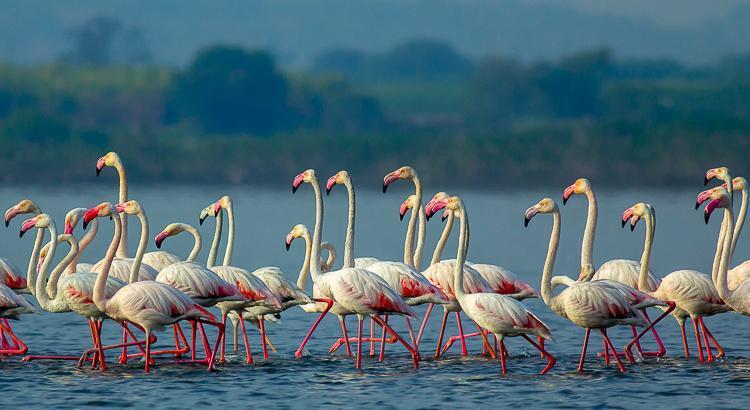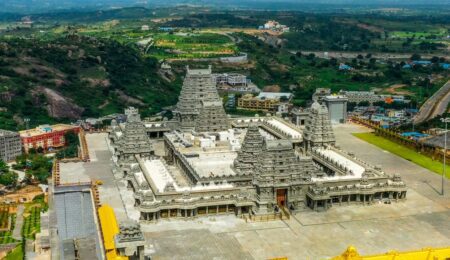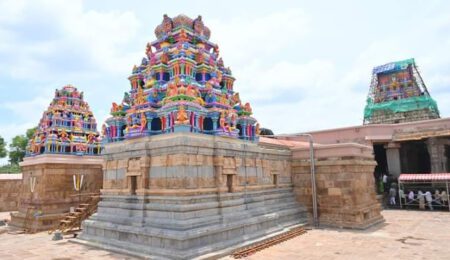Bhigwan Bird Sanctuary: A Paradise for Birdwatchers in Maharashtra
Bhigwan Bird Sanctuary Introduction
Far from the chaos of city life, where the sky kisses tranquil waters and the wind carries the sound of birdcalls, lies a picturesque haven for migratory birds and bird lovers alike. Bhigwan Bird Sanctuary, located on the border of Pune and Solapur districts in Maharashtra, is often hailed as the “Bharatpur of Maharashtra” for its rich avian biodiversity.
Each year during the winter months, thousands of birds including flamingos, herons, and raptors arrive here to rest, feed, and nest around the Ujani Dam backwaters. Though not officially declared a wildlife sanctuary, Bhigwan has earned a reputation as a must-visit destination for birdwatchers, photographers, and eco-tourists from all over India.
Let us explore the beauty, biodiversity, and experiences that Bhigwan Bird Sanctuary offers.
History and Ecological Importance
Bhigwan’s journey into a birdwatching hotspot began with the construction of the Ujani Dam on the Bhima River in the late 20th century. The resulting backwaters created a vast wetland ecosystem ideal for aquatic life, which in turn attracted migratory birds from colder regions of Asia, including Siberia, Central Asia, and Eastern Europe.
The wetlands and surrounding marshlands support not only birds but also aquatic plants, fishes, frogs, and microorganisms, forming a rich ecological tapestry. This natural habitat, although fragile, thrives because of the interdependence of these species.
Despite the lack of formal recognition as a sanctuary, the area enjoys community-driven conservation. Villagers from Kumbhargaon and Diksal are now trained guides, helping monitor and protect the habitat while also benefiting economically through eco-tourism.
Where Is Bhigwan Bird Sanctuary Located?
Bhigwan is situated in Indapur Taluka, on the border of Pune and Solapur districts, around 105 km from Pune, 250 km from Mumbai, and 70 km from Baramati. The sanctuary primarily spans two regions:
Kumbhargaon – known for boating and flamingo sightings
Diksal – offers diverse bird sightings from the land
How to Reach Bhigwan Bird Sanctuary
By Road: Well-connected by NH-65. Pune to Bhigwan takes approximately 2.5 to 3 hours
By Rail: Daund Junction is the nearest major railway station, 30 km away
By Air: The nearest airport is Pune International Airport
From either Daund or Pune, private cabs and local transport are available
Biodiversity at Bhigwan Bird Sanctuary
The sanctuary boasts over 230 species of birds, making it one of the richest birding hotspots in Maharashtra. The diversity includes waders, raptors, waterfowl, scavengers, and rare migratory species.
Star Attractions of Bhigwan Bird Sanctuary
1. Flamingos (Greater Flamingo)
They are the primary attraction. Their arrival from November to March turns the waters pink, offering a breathtaking sight at sunrise or sunset.
2. Waterbirds and Waders
Painted Storks
Glossy Ibises
Black-headed Ibis
Purple Swamphen
Egrets and Herons
Northern Shoveler
Eurasian Spoonbill
Common Coots
Woolly-necked Stork
3. Raptors
Marsh Harrier
Eurasian Hobby
Osprey
Short-toed Snake Eagle
4. Other Species
Bar-headed Geese
Demoiselle Cranes
Pied Kingfisher
Common and White-throated Kingfisher
Greylag Goose
Indian Cormorants
Jacanas, Stilts, and Lapwings
Each visit can surprise birders with different sightings depending on the time of day and water levels.
Wetland Ecology and Ecosystem Services
Bhigwan Bird Sanctuary is a classic example of a wetland ecosystem, which provides essential ecological services such as:
Water filtration
Flood control
Climate regulation
Carbon sequestration
Biodiversity preservation
These wetlands also serve as critical breeding grounds and stopover points for migratory species. Preservation of such ecosystems is essential not just for birds but also for sustainable local livelihoods and long-term environmental health.
Best Time to Visit Bhigwan Bird Sanctuary
Ideal Season
December to March is considered the best time for birdwatching.
Best Time of Day
Early Morning (6:00 AM to 9:00 AM) – Perfect for bird activity and lighting
Evening (4:00 PM to Sunset) – Great for photography and calm waters
During summer and monsoon months (April to September), bird activity drastically reduces as migratory birds return to their native lands.
Bird Photography at Bhigwan Bird Sanctuary
Bhigwan has become a photographer’s paradise, especially during the golden hours. From action shots of birds in flight to portraits of flamingos in still waters, the region provides diverse frames.
Tips for Photography
Use a zoom lens (300mm or more) for close-ups
Choose a fast shutter speed for birds in flight
Shoot in RAW format for better post-processing
Hire a local guide for access to the best spots
Carry a waterproof cover for your camera on boat rides
Drone photography is not allowed without prior permission.
Boating Experience in Bhigwan
The boating experience in Bhigwan is unique. Locally operated boats, often manually rowed or motorized with low-noise engines, take you close to where flamingos and other birds gather in the shallow waters.
Boating Details
Duration: 1 to 1.5 hours
Cost: ₹600 to ₹1200 per boat (4 to 6 people)
Available from sunrise to 10:30 AM and again after 4 PM
Life jackets are usually provided
Local guides act as boatmen and bird spotters, sharing stories and identifying rare species during the trip.
Ecotourism and Community Involvement
One of Bhigwan’s most inspiring aspects is its community-led tourism model. Villagers from Kumbhargaon and Diksal have turned into bird guides, photographers, and conservationists. This has created sustainable income for locals while promoting environmental awareness.
The community has established:
Birdwatching shelters
Viewpoints
Campsites and homestays
Eco-restaurants serving local cuisine
By supporting these guides and services, tourists directly contribute to rural development and wetland conservation.
Places to Visit Near Bhigwan Bird Sanctuary
Bhigwan can be part of a weekend itinerary with nearby attractions, especially for nature and history lovers.
Bhuleshwar Temple (50 km)
A 13th-century temple carved in black basalt rock. Known for its reverse Ganesha idol
Mayureshwar Wildlife Sanctuary (35 km)
Famous for Indian gazelles, mongoose, and grassland birds
Ujani Dam and Backwaters
Great for boating, sunset photography, and relaxation by the water
Baramati Wine Tourism
Explore vineyards like Four Seasons Winery and enjoy wine tasting tours
Where to Stay – Accommodation Options
Though Bhigwan is still emerging as a tourism hub, it offers various options to suit all budgets.
Local Homestays (Highly Recommended)
Located in Kumbhargaon village
Comfortable, with local food and guidance
Average cost: ₹600 to ₹1000 per night
Hotels in Baramati, Daund, or Indapur
Mid-range accommodations available
Suitable for families or larger groups
Tent Camping (Seasonal)
Limited operators provide camping packages by the lake
Ideal for nature lovers and photographers
Essential Tips for Visitors
Carry binoculars, a hat, sunscreen, and water bottles
Wear dull-colored clothes to avoid startling birds
Avoid playing loud music or making noise
Respect private farmland boundaries
Support local guides instead of venturing solo
FAQs About Bhigwan Bird Sanctuary
1. What are the flamingo viewing months in Bhigwan?
Flamingos arrive in December and stay until March, depending on water levels and climate
2. Are there facilities for food and toilets?
Yes, basic facilities are available in homestays and villages like Kumbhargaon. Restaurants offer local Maharashtrian food
3. Can families and children visit?
Absolutely. It’s a family-friendly destination, and children often enjoy the boat rides and birdwatching
4. Are pets allowed in Bhigwan?
It is not advisable to bring pets, as they may disturb the birds or not be allowed on boats
Conclusion
Bhigwan Bird Sanctuary is a treasure trove of biodiversity nestled within the heart of Maharashtra. Whether you are a seasoned ornithologist, a curious traveler, or someone simply looking to escape into nature’s calm embrace, Bhigwan offers a magical blend of birds, wetlands, and community warmth.
With its growing importance as an ecotourism destination and its spectacular natural beauty, Bhigwan calls out to be explored, respected, and preserved. Plan your trip this winter. The flamingos are waiting.




Leave a Comment